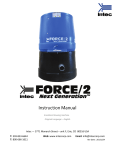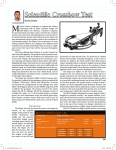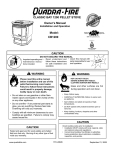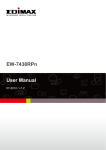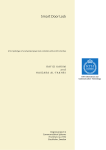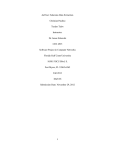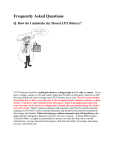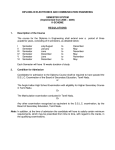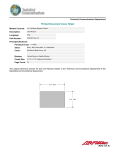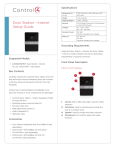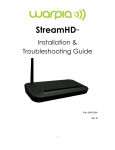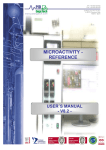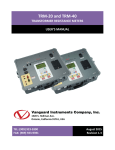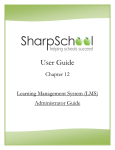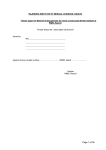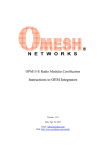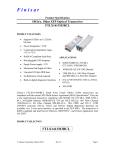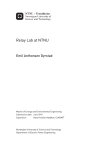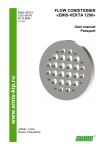Download File - Content Delivery in Ad
Transcript
Content Delivery in Ad Hoc Wireless Networks Design Document Dec 10-03 Client: Iowa State University Department of Electrical and Computer Engineering Advisors: Prof. Lei Ying Ming Ouyang Team Members: Wyatt Brenneman Taylor McKechnie Prashanth Yanamandra December 6, 2010 1 Iowa State University – Content Delivery in Ad Hoc Wireless Networks TableofContents List of Figures 4 List of Tables 5 List of Definitions 6 Executive Summary 7 Acknowledgement 8 Problem Statement 8 Operating Environment 9 Intended Users and Intended Uses 9 Assumptions 10 Limitations 10 Expected End Product and Deliverables 10 Functional Requirements 11 Non-Functional Requirements 11 Technology Considerations 12 Safety Requirements Considerations 13 Possible Risks and Risk Management 14 System Decomposition 14 Detailed Design 14 Details of Hardware 16 Software Design 17 Testing and Evaluation 18 Testing Phases 18 Evaluation 19 Test Results 19 2 Iowa State University – Content Delivery in Ad Hoc Wireless Networks Estimated Resources 21 Project Schedule 22 Task Breakdown 22 Team Information 24 Closing Summary 25 References 26 Appendix 27 3 Iowa State University – Content Delivery in Ad Hoc Wireless Networks ListofFigures Concept Sketch 8 Operating Environment 9 USRP Box 12 TelosB Sensor 12 System Decomposition 13 USRP Circuitry 15 USRP Block Diagram 16 Data Packet Sent From USRP 19 Data Received by USRP 19 Sensor Data Received by USRP 20 Sensor Data Relayed by USRP to Base Station Sensor 20 Light Sensor Graphical Data 21 Project Schedule 22 4 Iowa State University – Content Delivery in Ad Hoc Wireless Networks ListofTables Intended Users and Intended Uses 9 Semester 1 Task Breakdown 22 Semester 2 Project Task Breakdown 23 5 Iowa State University – Content Delivery in Ad Hoc Wireless Networks ListofDefinitions Wireless Ad-hoc Network: A decentralized wireless network which does not depend on preexisting infrastructure like routers but each node participates in data transmission.[1] USRP/USRP2 (Universal Software Radio Peripheral): USRP/USRP2 is a general purpose RF hardware device designed by Ettus Research which provides a low-cost, readily but versatile radio functionality. GNU Radio: GNU Radio is an open-source software development toolkit for the development of software-defined radios. It contains a variety of signal processing algorithms that we will use on the data collected by the USRP hardware. P2P (Peer to Peer): A system where the users both supply and consume the data available on the network. SD Card (Secure Data Card): A non-volatile memory card which would be used to store programming for the USRP2 in its standalone operation mode. BER (Bit Error Rate): The number of erroneously received bits divided by the total number of transmitted bits. BER is unit-less and expressed as a percentage. TinyOS: TinyOS is a free and open source component-based operating system that is written using the nesC programming language. [2] 6 Iowa State University – Content Delivery in Ad Hoc Wireless Networks ExecutiveSummary As the understanding of the world around evolves and grows, the control and distribution of information is key to the continual growth and progress of society. Previous exchanges of information required physically receiving the information from the source, receiving it from a third party, or from large network sources such as the internet. These previous methods were not conducive to real time sharing of information between individuals. Our project will allow users to stream data onto the network for others to view immediately and straight from the sources of the information. A team of three Iowa State University College of Engineering students will work to create an ad Hoc wireless network which will allow the ability of users to stream information using P2P traffic. Our group will implement this network with several USRP and USRP2 radios, wireless sensors, and the GNU Radio protocol. 7 Iowa State University – Content Delivery in Ad Hoc Wireless Networks Acknowledgement: Our group would like to thank Iowa State University for providing the equipment needed for the project including the USRPs, USRP accessories, and laptops used to complete this project. We would also like to thank our faculty advisor Professor Lei Ying and his PhD student Ming Ouyang for answering our questions about the project and helping troubleshoot the errors that we encountered. ProblemStatement Wireless connectivity has become popular in our everyday life and the ability to exchange information is increasing just as fast. Examples of technologies implementing ad-hoc networks include Wi-Fi, Bluetooth and Zigbee. Our goal is to establish communication between USRPs, USRP to Sensor and Sensor to Sensor using Zigbee protocol (IEEE 802.15.4). This protocol operates at 2.4GHz broadcasting frequency. We will be implementing a star network topology for our sensor networks. We also aim to print useful data obtained from the sensors Figure: Concept Diagram 8 Iowa State University – Content Delivery in Ad Hoc Wireless Networks OperattingEnvirronment: Operatin ng Environmeent: The eventtual network envisioned e fo or this project will be proviiding P2P streeaming servicce for an individuall building witth the users acccessing the network n also inside the buiilding. Becauuse our system m will be op perating indoo ors to providee network cov verage for the entire buildinng we won’t hhave to worryy about exteernal weatherr conditions affecting the equipment or tthe transmisssion of the datta. Since our network will w be operating indoors, the t network will w need to ovvercome the m many stationaary physical ppath obstacles as well as sm maller moving path obstacles.. ojects may bee Future pro implemen nted to provid de an outdoor network n and will w need to prrovide physical protection n from temperrature, rain, dust,, weather conditionss, wildlife, an nd vandalism m. Moving the network outside o will allso require co ompensating the t data signaal for adverse weather conditions to improve reliability. r Intended User Intended Use Non-tech hnical unknowleedgeable periphera al device user Wirelesssly broadcassting informattion to other uusers around tthe area who can seee it in real tim me. Should nott require any knowledge of how backgro ound network k works, user only has to start transmittiing by hittingg a “broadccast” button and a it should bbroadcast thee data to all ussers from therre until th he user ends fiilming. Administtrator Manage feeds on thee network, lim miting and/or cutting the coonnectivity of ones th hat become too o much of a hhindrance to tthe network. Commerccial user Broadccast of meetin ng or demonsttration from oon-site area too an office buildin ng or safe-zon ne. Educational user Use of our project ass an educationnal tool for w wireless sensoor commu unication netw works. 9 Iowa State University U – Content Deliv very in Ad Hooc Wireless N Networks Assumptions Minimum user access: The system works only when there is at least one user who is broadcasting and at least one user streaming the data. Users within the range of sensors: Users will be able to get best reception when they are in the range of about 100 feet from the sensory/ USRP network. USRP and Laptop in same location: The USRP does computations when it is connected to a laptop and will not function as a stand-alone system. The USRP2 does allow the use of an SD card instead of an external laptop for computation. However, using the SD card reduces the number and complexity of computations available to the USRP2. Indoor Network: The USRP and sensors will be placed indoors so physical protection from weather elements will not be needed. We also will have to compensate for signal degradation due to walls and reflections. Limitations The equipment is not built to operate in extreme temperatures and should be kept indoors. ExpectedEndProductandOtherDeliverables The end product delivered will be Communication between USRPs and sensors The kinds of communication that will be available are USRP to USRP, Sensor to Sensor, USPR to Sensor, Sensor to USRP, and Sensor to USRP to Sensor. OtherDeliverablesinclude Project Plan Document The project plan document highlighting the proposed approach plan will be provided at the completion of the project Design Document The design document highlighting the design approach considered for the project will be provided at the completion of the project. 10 Iowa State University – Content Delivery in Ad Hoc Wireless Networks Design Review Presentation The presentation made for the design review will be provided at the completion of the project Project Poster The poster designed highlighting our achievements for the project will be provided at the completion of the project User Guide A user manual will be provided to the user upon completion of the project in order to act as a reference on how each element of the system works. This document will include a software guide as well as instruction sets that assist with training and reference material. FunctionalRequirements Streaming of Wireless Sensor Data throughout Network o Simultaneous Streaming o The fully functional system must be capable of supporting 10 simultaneous streams at any instant of time. The wireless motes require a unique ID # when programmed so sensor data can be tracked to the specific sensors. Utilize the Zigbee 802.15.4 Protocol o Our system will allow wireless sensor motes to stream sensor data to the USRP backbone of our system. The data will be propagated to other wireless motes through the USRP backbone. Our network will be operating in the 2.4 – 2.4835 GHz band, which is the worldwide band for Zigbee. We will be utilizing channel 16 of this band, which is at 2.48 GHz center frequency. Broadcasting range o The system must be able to provide good reception for users in a close range Non‐FunctionalRequirements Physical Dimensions 11 Iowa State University – Content Delivery in Ad Hoc Wireless Networks o Equipment E Pro otection o The diimensions of the t sensors neeed will needd to be small eenough to be implementedd in classro ooms and labss without needing to changge any layoutt of the room. The dimension of the US SRP is fixed. The eq quipment is placed indoorss at all times aand does not rrequire weathher protectionn. Power P Requireements o The USRP and the USRP2 need an AC to DC C converter. T The sensors w will need 2 AA A batteriies to supply power. p Techno ologyCon nsideratio ons Hardware H Con nsiderations o USRP: We choose to t use the US SRP because iit has been G Radio ssoftware. By specifiically designeed to use the GNU utilizin ng a software defined radio o, much moree flexibility iss given to t our system m by taking the much of thee system desiggn away from f hardwarre and given to t software deesign. o Sensorrs: The sensors used in ourr system m are Crossbo ow TelosB sensorrs. We choosee these becau use they in nclude voltagee, temperrature/humidiity, visible lig ght spectru um, and visib ble light to infrareed sensors. These sensors can alsso be easily programmed p using TinyOS T and are a powered by b only tw wo AA batterries. So oftware Conssiderations o 12 Daughterbo oard: The USRP daughterrboard that w we have chosen n to use is thee RFX2400 T Transceiver. T This will allow us u to transmitt and receive w with only onee antenna and d also operatees within the w worldwide Ziigbee 802.15.4 baand. GNU Radio: R GNU Radio is an open-source o sooftware devellopment toolkkit which enaables a variety y of signal pro ocessing on th he data colleccted by the US SRP hardwarre. GNU radioo is a Iowa State University U – Content Deliv very in Ad Hooc Wireless N Networks software interface to the USRP. There are also many projects using GNU Radio and USRPs and we can utilize these projects as a resource for learning. o TinyOS: We will be using TinyOS for programming the wireless motes because it utilizes nesC which is very similar to C syntax and allows component blocks to be tied together easily. SafetyConsiderations Excessive exposure to radio frequency o Being exposed to excessive radio frequency can lead to health hazards No interference o Equipment used for this project will not interfere with other radio devices which include wireless 2 way radios. All the technology used here is purely for educational purposes and not for jamming other equipment or for destructive purposes. RisksandMitigationPlans The project is designed with precision and quality; however, there are certain risks, which could be encountered during the course of project lifetime. The possible risks are indicated below: Device/Sensor failure o Data Transmission Overlap o 13 Sensors are prone to fail with increasing time and usage. To reduce the effect of sensor failing on the system, our team is planning to overlap sensors and make a mesh network. Taking this approach, we will be able to use other sensors to route the data temporarily, until the sensor is repaired/ replaced. The sensors we plan to use are commonly available and will be easy to order and replace. Data being sent across a wireless medium is will end up travelling in multiple paths to the receiver. This can cause deconstructive interference from phase shifting and congestion in the system. We will implement a way to recognize the desired signal and reduce the chance of propagating duplicate signals. Iowa State University – Content Delivery in Ad Hoc Wireless Networks SystemDecomposition The USRP sends and receives information from the video sensor wirelessly at 2.4GHz. The data packets received from the video sensor are processed by the FPGA in the USRP. The processed data is then sent to the laptop computer through a USB cable or a gigabit cord. Laptop Java: Serial Forwarder Oscilloscope GNU Radio Python/ C++ Code TinyOS Application Code TinyOS Application Code USRP Data Sensor Node ADC Microprocessor Antenna FPGA ADC Transceiver Daughterboard DAC DAC Light Sensor Base Station Node Temp/Humidity Sensor Antenna Microprocessor Antenna Figure: System Decomposition DetailedDesignOverview USRP For our project we will be using the USRP as well as the newer USRP2 to provide the hardware interface of our radio system. The main reason for using the USRP/USRP2 is that they were designed with the GNU Radio software in mind and created to maximize the capabilities of GNU Radio. The USRP/USRP2 design is also open source, which means that all of the tools we will be using to create our final product are open source. This fact allows us forgo typical software and licensing fee that could be attributed to a typical project of our nature. 14 Iowa State University – Content Delivery in Ad Hoc Wireless Networks Figure: Trasnsceiverr Daughter boarrd used in USRP 15 Iowa State University – Content Deliv very in Ad Hooc Wireless N Networks DetailssofHardw ware For both our o USRP and d USRP2 mod dules we willl be using the same antennnas and daughhterboards. Antenna: A We will w be using the t VERT245 50 antenna onn all of our U USRPs. Dual band b 2.400 – 2.800 2 GHz an nd 4.900 – 5.9900 GHz. Daughterboard D d: We will bee using the RF FX2400 Trannsceiver daughhterboard in aall of our USR RPs. Fully controllable c th hrough radio software or F FPGA Transm mitting powerr of 50mW (1 17 dBm) Able to transmit and receive thro ough one anteenna and boarrd connectionn 30 MH Hz transmit an nd receive ban ndwidth Frequeency range off 2.300 – 2.90 00 GHz The first generation g US SRP utilizes 4 high-speed ADCs A and DA ACs which arre connected to an Altera Cyclone EP1C12 E FPGA A. The USRP P also uses USB2 U to interfface with lapttop. Analog A to Digiital Converterrs 64 Ms/s at 12-bit Digital D to Anallog Converterrs 128 Ms/s M at 14-bits nd generation USRP2 also The secon utilizes 4 high-speed ADCs A and DA ACs, x which aree then connectted to a Xilinx Spartan 3-2000 FPGA which then connects to t a Gigabit Ethernet E interfface. Analog A to Digiital Converterrs 100 Ms/s M at 14-bit Digital D to Anallog Converterrs 400 Ms/s M at 16-bits 16 Iowa State University U – Content Deliv very in Ad Hooc Wireless N Networks SoftwareDesign USRP Software o The software packages that were used for the USRP software are GNU Radio and UCLA Zigbee PHY. The UCLA Zigbee PHY project was created to extend GNU Radio to interoperate with Chipcon CC1000 and CC2420 radios. We choose to use this because it is an open source project and the TelosB mote uses a CC2420 radio for its wireless transmission. This allowed us to focus on writing an application for our sensor network without having to write all the physical layer coding needed for Zigbee. Our python script utilizes two of the example codes provided by the UCLA Zigbee PHY project. The project provides a basic transmission script and a basic receive script for sending and receiving packets formatted for the CC2420 chip. Since we want our program to be able to transmit and receive messages simultaneously we needed to combine the two scripts effectively. The original receive script would send the same message every time, but since we are forwarding the messages that are received we needed to parse the incoming data into its Frame Control Field (FCF), packet number, address info, payload, and Cyclical Redundancy Check (CRC). We then took the packet number, address info, and payload and passed it to the send_pkt() function. This function is part of the UCLA Zigbee PHY library, which generates an FCF and CRC for packet information and then sends the data to the USRP. One of the largest problems with combining the two separate scripts was that both scripts were written assuming no other program would be accessing the daughterboard. This meant that initially that the USRP could only receive or only transmit. The solution for this problem was to create a new top level class where both the receive path and transmit path are activated and then combined. Since this became the top level class, this forced the receive and transmit classes to become second level blocks and changing some of the class initialization functions. After connecting both transmit and receive paths together we were then able to transmit and receive at the same time, but we needed to add a check that the packet received was not just transmitted. This prevents the USRP from creating an infinite loop where it will continually send the same message since it is picking up the message it has just transmitted. TinyOS Software o 17 To test the functionality of our system of receiving and sending packets from the TelosB motes we used a basic example application with a few modifications. We choose to use the Oscilloscope and BaseStation applications provided by TinyOS. Iowa State University – Content Delivery in Ad Hoc Wireless Networks The Oscilloscope application takes sampled sensor data and transmits it wirelessly using the CC2420 chip. The data packet contains 10 readings 16-bit sensor data as well as mote id. The default sensor for the Oscilloscope program was a voltage sensor that measured the supply voltage of the microprocessor. While this data can be useful to determine if the batteries may need to be replaced in a mote, the data is nearly constant and is not useful for a demonstration. To make this application interactive for our demonstration we choose the sensor that it would be reading to the Hamamatsu s1087 visible light sensor. This allows us to see drastic changes in the sensor readings by affecting the amount of light that reaches the sensor to verify the real-time transmission of the data. TestingandEvaluation Testing will be performed in various stages during the course of the project. The initial stage of testing includes testing the system by sending data packets from one USRP to another USRP. We will then move to testing communications between the USRPs and the sensors. Testing Phases As was stated earlier the first stage is testing communication between the USRP devices. This was done by sending various packets from one USRP to another and checking them to ensure they were the same packet. We had some user error here when putting in the frequency to transmit and receive on. The second stage was testing the sensor to sensor communication. In this phase of testing, a sensor transmitted either light, voltage or temperature readings as data packets to the base station (a sensor programmed to be a receiver connected to the laptop). The base station printed out the information received from the transmitter sensor using the Java Oscilloscope application. The third stage was testing the sensor to USRP communication. Data packets were sent back and forth between the sensor and the USRP. Data sent from the sensor to the USRP was printed to the screen and then using another java application included with TinyOS called Listen we printed the data received by the base station sensor. In this stage we had to ensure the received payload was parsed correctly and preserved their formatting to prevent any packets failing which the packet would be dropped. The final stage of testing was sending a packet from a senor to a USPR and then to another sensor. In this stage we had to ensure that the packet was successfully received and transmitted. To do this we had to ensure the correct parts of the packet were stripped away when it was received so that the payload (packet data) was left unchanged. When moving from receiving to transmission we ran in to an error of the USRP receiving the packet it was transmitting in a continuous loop. 18 Iowa State University – Content Delivery in Ad Hoc Wireless Networks Evaluatio on Data pack kets will be traansmitted from a TelosB sensor s to an U USRP. The US SRP will prinnt out the receeived sensor datta. It will sim multaneously trransmit the reeceived data tto another US SRP. The seccond USRP w will print the received r data.. We will then n compare thee received datta with the traansmitted datta to check forr error free transmission. The USRP will w then transmit the data to the sensorrs, which will confirm the ddata received by b a light blin nk. This multii-hop transmission will cheeck full system m functionaliity correctnesss. TestRe esults Figure: Data Packet Sent Froom USRP Figure: Data Received by USRP The abovee figures show w our hardcod ded message from the trannsmitted USR RP to the seconnd USRP. Thhe FCF is geenerated by an n underlying python p script ieee802_15__4_pkt.py andd we have modified it to giive the FCF needed n by the TelosB motee. The CRC is i also generaated by the sam me underlyinng script and is based on the t data sent and acts as an n error check for received ppackets. 19 Iowa State University U – Content Deliv very in Ad Hooc Wireless N Networks Figure: Sensor D F Data Received b y the USRP For this teest condition we w sent data from f the Telo osB mote andd received the data on the U USRP. Since the mote is wireless w and un nconnected to o a computer we w cannot veerify the exactt data. Howeever, we can ssee that the paacket numberr is increasing g by one and the t mote id iss constant. T The payload ddata […,0,3,0,4,0,3,…,0,3,0 0,3,…] are thee sensor readiings. Each reeading is a 166-bit integer aand we covereed the light sensor for this tesst so the valuees received are reasonable for this experriment. Figure: Se ensor Data Relayyed by USRP to Base Station Seensor yOS will dropp any duplicaate packets soo to ensure thaat the In this tesst, the BaseStaation applicattion from Tiny USRP waas properly forrwarding the received pack ket we modiffied the mote id. This resuults in the BaseStatio on app pickin ng up two pacckets: one direectly from thee sensor and oone from the USRP. The ffifth byte deno otes the mote id i change and d as one can see s the rest off the data is thhe exact samee for all other bytes which sho ows that the packet p is forw warded correcttly. 20 Iowa State University U – Content Deliv very in Ad Hooc Wireless N Networks Figure: Lightt Sensor Graphiccal Data Estima atedResou urcesand dCost Resource Numbeer of Units Cost per Unnit Total USRP (Base Kit) 2 $700 $1,400 USRP2 (B Base Kit) 3 $1400 $4,200 RFX 2400 Transceiveer daughterrboard 5 $275 $1,375 VERT 24 450 Antenna 5 $35 $175 Sensors 20 $139 $2,780 Laptops 5 $800 $4,000 Work Ho ours 450 $20/Hour $9,000 SD Cardss 3 $20 $60 Total Cosst 21 $22,9900 Iowa State University U – Content Deliv very in Ad Hooc Wireless N Networks ProjecttSchedule Figure e: Red bars indicate the projectt completed andd blue bars indiccate work to be completed TaskB Breakdow wn Semeste er1 Research Hardwa are Implementtation Wyatt Brrenneman 35 5 10 30 80 Taylor McKechnie M 40 0 10 25 75 Prashantth Yanaman ndra 35 5 10 30 80 105 10 30 90 215 Total 22 S Software Dessign D Documentatioon Iowa State University U – Content Deliv very in Ad Hooc Wireless N Networks Total Semester2 Transmission Receiving Wyatt Brenneman 20 20 5 30 30 105 Taylor McKechnie 10 10 10 10 30 70 5 5 5 5 40 60 35 35 20 45 100 235 Prashanth Yanamandra Total Testing 23 Signal Processing Iowa State University – Content Delivery in Ad Hoc Wireless Networks Documentation Total Client/AdvisorsInformation Professor Lei Ying 3219 Coover Hall Ames, IA 50011 [email protected] 515 294-5353 Ming Ouyang 2215 Coover Hall Ames, IA 50011 [email protected] 515 294-2664 ProjectTeamInformation Wyatt Brenneman 232 Walnut Ave Unit 16 Ames, IA 50010 [email protected] 319 981-7003 Taylor McKechnie 225 Hyland Ave Apt 12 Ames, IA 50014 [email protected] 402 926-1033 Prashanth Yanamandra 143 University Village Apt F Ames, IA 50010 [email protected] 321 704-6321 24 Iowa State University – Content Delivery in Ad Hoc Wireless Networks ClosingSummary In a world where the need of fast and reliable exchange of information is growing our network will showcase one possibility of how this can be achieved. Our network will rely on the flexibility of P2P sharing and combine it with the immediate gratification of streaming data. By streaming the data the users will not be required to wait to view the information they need as well and continue to propagate the data through the network. 25 Iowa State University – Content Delivery in Ad Hoc Wireless Networks References [1] Crossbow Wireless Modules Portfolio – Crossbow Technology. Retrieved March 1, 2010. From the World Wide Web : < http://www.xbow.com/Products/productdetails.aspx?sid=156>. [2] TinyOS." Wikipedia, the free encyclopedia. Retrieved December 4, 2010 from the World Wide Web: <http://en.wikipedia.org/wiki/TinyOS>. [2] Ettus Research LLC. Retrieved March 1, 2010. From the World Wide Web : <http://www.ettus.com/>. [3] "GNU Radio”. Retrieved March 1, 2010 from the World Wide Web. <http://gnuradio.org/trac>. [4] "GNU Radio." Wikipedia, the free encyclopedia. Retrieved March 1, 2010 from the World Wide Web: <http://en.wikipedia.org/wiki/GNU_Radio>. [5] ISU Electrical and Computer Engineering: ECpE Building Addition and Coover Hall Renovations Project. Retrieved March 1, 2010 from the World Wide Web: <http://www.ece.iastate.edu/typo3temp/pics/6552a907c0.gif>. [6] Jackey, John. FPGA for MRFM Cantilever Control. Retrieved April 26, 2010 from the World Wide Web :< http://www.research.cornell.edu/KIC/events/MRFM2006/pdfs/Jacky%20talk/jackytalk. html>. [7] “Peer-to-peer.” Wikipedia, the free encyclopedia. Retrieved March 1, 2010 from the World Wide Web: <http://en.wikipedia.org/wiki/Peer-to-peer>. [8] "Universal Software Radio Peripheral." Wikipedia, the free encyclopedia. Retrieved March 1, 2010 from the World Wide Web: <http://en.wikipedia.org/wiki/Universal_Software_Radio_Peripheral>. 26 Iowa State University – Content Delivery in Ad Hoc Wireless Networks Appendix The appendix contains the code designed for the transmitting and receiving functions of the USRP #!/usr/bin/env python # # This program was written for a senior design project at Iowa State University # under the supervision of Professor Lei Ying, and Ming Ouyang. # # Receives and Forwards 802.15.4 RADIO packets from TelosB Wireless sensor motes # # This code is a modified combination of cc2420_rxtest.py and cc2420txtext.py # from the UCLA Zigbee PHY project examples. The cc2420_rxtest.py and # cc2420_txtest.py were created By: : Thomas Schmid, Leslie Choong, Mikhail Tadjikov, # and Sanna Leidelof. # # Written and Modified by: Wyatt Brenneman and Taylor Mckechnie from gnuradio import gr, eng_notation from gnuradio import usrp from gnuradio.ucla_blks import ieee802_15_4_pkt from gnuradio.eng_option import eng_option from optparse import OptionParser import math,struct, sys, random def pick_subdevice(u): """ The user didn't specify a subdevice on the command line. If there's a daughterboard on A, select A. If there's a daughterboard on B, select B. Otherwise, select A. """ if u.db(0, 0).dbid() >= 0: # dbid is < 0 if there's no d'board or a problem return (0, 0) if u.db(1, 0).dbid() >= 0: return (1, 0) return (0, 0) class stats(object): def __init__(self): self.npkts = 0 self.nright = 0 #//////////////////////////////////////////////////////////////////////////////////////////// # Combine Transmit and Receive Paths #//////////////////////////////////////////////////////////////////////////////////////////// class path_block(gr.top_block): i=0 mote_id_sent = 0 packet_num_sent = 0 def __init__(self): gr.top_block.__init__(self) def rx_callback(ok, payload): 27 Iowa State University – Content Delivery in Ad Hoc Wireless Networks payload2 = map(hex, map(ord, payload)) payloaddec = map(ord, payload) packet_num = payload[2] mote_id = payload[7] #app.start() if path_block.i==0: #Allows for first received packet to be transmitted print "passing through initial if statement" st.npkts += 1 if ok: st.nright += 1 print "ok = %5r pktno = %d mote_id = %d len(payload) = %4d %d/%d" % (ok, ord(payload[2]), ord(payload[7]), len(payload), st.nright, st.npkts) print " --------------------------------------------------------------------------------------------------------------------------------------------------------" print "FCF: " + str(map(ord, payload[0:2])) print "Seq Num: " + str(map(ord, payload[2])) print "Address info: " + str(map(ord, payload[3:10])) print "Payload: " + str(map(ord, payload[10:39])) print "CRC: " + str(map(ord, payload[39:41])) print "Decimal Payload: " + str(payloaddec) self.txpath.send_pkt(payload,False) print "802_15_4_pkt: waiting for packet..." path_block.i=1 elif (path_block.packet_num_sent != packet_num and path_block.mote_id_sent == mote_id) or path_block.mote_id != mote_id: print" packet received." print "passing through secondary if statement" #Will not allow transmission if received packet was just transmitted #This prevents an infinite transmission loop st.npkts += 1 if ok: st.nright += 1 (pktno,) = struct.unpack('!H', payload[0:2]) print "ok = %5r pktno = %d mote_id = %d len(payload) = %4d %d/%d" % (ok, ord(payload[2]), ord(payload[7]), len(payload), st.nright, st.npkts) print " --------------------------------------------------------------------------------------------------------------------------------------------------------" print "FCF: " + str(map(ord, payload[0:2])) print "Seq Num: " + str(map(ord, payload[2])) print "Address info: " + str(map(ord, payload[3:10])) print "Payload: " + str(map(ord, payload[10:39])) print "CRC: " + str(map(ord, payload[39:41])) print "Decimal Payload: " + str(payloaddec) self.txpath.send_pkt(payload,False) print "802_15_4_pkt: waiting for packet..." 28 Iowa State University – Content Delivery in Ad Hoc Wireless Networks path_block.packet_num_sent = packet_num path_block.mote_id_sent = mote_id sys.stdout.flush() parser = OptionParser (option_class=eng_option) parser.add_option("-R", "--rx-subdev-spec", type="subdev", default=None, help="select USRP Rx side A or B (default=first one with a daughterboard)") parser.add_option("-T", "--tx-subdev-spec", type="subdev", default=None, help="select USRP Tx side A or B (default=first one with a daughterboard)") parser.add_option ("-c", "--cordic-freq", type="eng_float", default=2480000000, help="set rx cordic frequency to FREQ", metavar="FREQ") parser.add_option ("-r", "--data-rate", type="eng_float", default=2000000) parser.add_option ("-f", "--filename", type="string", default="rx.dat", help="write data to FILENAME") parser.add_option ("-g", "--gain", type="eng_float", default=0, help="set Rx PGA gain in dB [0,20]") (options, args) = parser.parse_args () st = stats() i=0 mote_id_sent = 'null' packet_num_sent = 'null' self.rxpath = oqpsk_rx_graph(options, rx_callback) self.txpath = transmit_path(options) self.connect(self.txpath) self.connect(self.rxpath) #//////////////////////////////////////////////////////////////////////////////////////////// # Recieve Block #//////////////////////////////////////////////////////////////////////////////////////////// class oqpsk_rx_graph (gr.hier_block2): def __init__(self, options, rx_callback): gr.hier_block2.__init__(self, "oqpsk_rx_graph", gr.io_signature(0, 0, 0), # Input signature gr.io_signature(0, 0, 0)) # Output signature print "cordic_freq = %s" % (eng_notation.num_to_str (options.cordic_freq)) self.data_rate = options.data_rate self.samples_per_symbol = 2 self.usrp_decim = int (64e6 / self.samples_per_symbol / self.data_rate) self.fs = self.data_rate * self.samples_per_symbol payload_size = 128 # bytes u = usrp.source_c (0, self.usrp_decim) if options.rx_subdev_spec is None: options.rx_subdev_spec = pick_subdevice(u) u.set_mux(usrp.determine_rx_mux_value(u, options.rx_subdev_spec)) 29 Iowa State University – Content Delivery in Ad Hoc Wireless Networks subdev = usrp.selected_subdev(u, options.rx_subdev_spec) print "Using RX d'board %s" % (subdev.side_and_name(),) u.tune(0, subdev, options.cordic_freq) u.set_pga(0, options.gain) u.set_pga(1, options.gain) self.u = u self.packet_receiver = ieee802_15_4_pkt.ieee802_15_4_demod_pkts(self,callback=rx_callback,sps=self.samples_per_symbol,s ymbol_rate=self.data_rate, threshold=-1) self.squelch = gr.pwr_squelch_cc(50, 1, 0, True) self.connect(self.u, self.squelch, self.packet_receiver) #//////////////////////////////////////////////////////////////////////////////////////////// # Transmit Block #//////////////////////////////////////////////////////////////////////////////////////////// class transmit_path(gr.hier_block2): def __init__(self, options): gr.hier_block2.__init__(self, "transmit_path", gr.io_signature(0, 0, 0), # Input signature gr.io_signature(0, 0, 0)) # Output signature self.normal_gain = 8000 self.u = usrp.sink_c() dac_rate = self.u.dac_rate(); self._data_rate = 2000000 self._spb = 2 self._interp = int(128e6 / self._spb / self._data_rate) self.fs = 128e6 / self._interp self.u.set_interp_rate(self._interp) # determine the daughterboard subdevice we're using if options.tx_subdev_spec is None: options.tx_subdev_spec = usrp.pick_tx_subdevice(self.u) self.u.set_mux(usrp.determine_tx_mux_value(self.u, options.tx_subdev_spec)) self.subdev = usrp.selected_subdev(self.u, options.tx_subdev_spec) print "Using TX d'board %s" % (self.subdev.side_and_name(),) self.u.tune(0, self.subdev, options.cordic_freq) self.u.set_pga(0, options.gain) self.u.set_pga(1, options.gain) # transmitter self.packet_transmitter = ieee802_15_4_pkt.ieee802_15_4_mod_pkts(self, spb=self._spb, msgq_limit=2) self.gain = gr.multiply_const_cc (self.normal_gain) 30 Iowa State University – Content Delivery in Ad Hoc Wireless Networks self.connect(self.packet_transmitter, self.gain, self.u) self.set_gain(self.subdev.gain_range()[1]) # set max Tx gain self.set_auto_tr(True) # enable Auto Transmit/Receive switching def set_gain(self, gain): self.gain = gain self.subdev.set_gain(gain) def set_auto_tr(self, enable): return self.subdev.set_auto_tr(enable) def send_pkt(self, payload, eof=False): print " --------------------------------------------------------------------------------------------------------------------------------------------------------" return self.packet_transmitter.send_pkt(ord(payload[2]),payload[3:10] ,payload[10:39], eof) def main (): app = path_block() app.start() app.wait() if __name__ == '__main__': main () 31 Iowa State University – Content Delivery in Ad Hoc Wireless Networks































